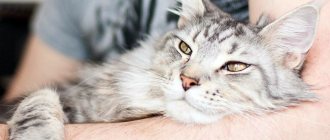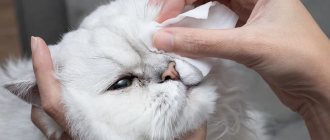Come home after a working day, stretch out in your favorite chair, grab a cup of tea, turn on your favorite TV channel. Perfect picture! But many people miss the gentle purring above the ear, the feeling of fur under their fingers and just a living creature nearby.
And so they get a cat.
It would seem that getting a cat is a simple matter. Especially if you just need a cat, and not an expensive pet of a specific complex breed. There are many options, starting from advertisements “I’ll give the kitten to good hands” and ending with visiting nurseries, where, if you’re lucky, you can get a cat with all the necessary vaccinations.
But getting a cat is only half the battle. The most important thing is what to do with him later in order to become friends with this cat, and not enemies.
Don't "raise" a cat
Cats don't like that!
Many people are sure: it is important to immediately show who is boss in the house. And preferably, so that the cat understands this once and for all. One of the tips that can be found on the Internet is to grab the cat by the scruff of the neck, lift it higher and shake it thoroughly. Well, so that he knows his place. Some may even spank the animal a couple of times, apparently to reinforce the result. So, if you are given such advice, do not listen.
Because felinologists unanimously say: a cat is not a dog, he always hunts alone and, accordingly, does not need organization and distribution of roles. It’s stupid to explain to a cat what submission and control are; he simply won’t understand what you want from him. The cat-owner relationship is built on mutual sympathy and the cat's sense of security. A cat needs a close creature to cuddle up to, purr next to (at the same time ask for food), and trustingly curl up on his lap. If you start raising a cat using the above methods, then the cat will no longer consider you as a close being.
Handle your cat correctly
You can pick up a cat, but it is important to do it correctly. Otherwise, instead of purring and caressing, you may hear an aggressive hissing and earn a scratch or two. You cannot hang over the cat with your whole body, or stroke it by pressing from the front. No cat likes to have someone look directly into her eyes or have her face brought close to her face. The cat will rarely tolerate such an attitude; most likely, he will bite or run away.
You need to pick up the cat gently, turning away slightly. You can stroke it at the base of the ears.
Don't take traumatic liberties with your cat
If your cat tries to play with your hand or cling to your legs, don't let him - he could hurt you. A sharp snort works well on a cat - “Pfft!” "(this is the sound kittens hear from their mother cat, it is familiar to them), after which you need to quickly remove your hand and give the cat a toy. Or a cloth if you don’t have a toy. Hearing from you “Pff! “, the cat must stop pampering immediately. If he didn’t stop, it means you said too quietly and unconvincingly, “Pfft!” ". This action redirects the cat's play instinct from your hand to another object (in this case, a toy or rag). Simply prohibiting someone from playing with your arm or leg will lead to nothing.
Not everyone likes an endlessly meowing cat that doesn’t leave your side as soon as you cross the threshold of the house. This largely depends on the breed of the pet. For example, oriental cat beauties (Oriental, Somali, Abyssinian, Thai, Sphynx, Bobtail, etc.) need more human communication than other more self-sufficient breeds. They will follow you around, touch everything you touch, take cookies off your plate (or cosmetics right from under your nose), and purr a lot.
Northern cat breeds – Siberian, Norwegian Forest and others – are considered calmer and more self-sufficient.
What does a kitten owner need to know?
Got a kitten: what to do? (advice for a novice owner)
A kitten, a little bundle of happiness, has settled in your home. The moment came when with great joy came great responsibility. It can be difficult for a novice owner to get used to a new role and understand what needs to be done to properly care for a kitten. If you have adopted a kitten and want to figure out what to do next, be sure to read on - the Murkosha shelter team has prepared a tour for you with important information on the topic.
Some interesting facts about kittens
- The kitten begins to walk only at three weeks of age. Before this, he is actually crawling.
- Until he is a month old, the kitten still does not know how to hide his claws and sharpen them. But a month-old baby already needs to buy a scratching post and teach the kitten to use it.
- A kitten, like a human, has milk teeth. By three months, kittens have 26 of them.
- You need to feed the kitten 4-5 times a day. This tight feeding schedule must be maintained in order for the kitten to grow up strong and healthy.
What does a kitten owner need to know?
In the first days in a new place, many kittens behave restlessly: they rush around the apartment, do not give in to hands, meow at night and are always trying to climb somewhere. This behavior is normal. The owner needs to be patient and explain to the kitten through his actions that the new environment is safe and many pleasant experiences await him here. Feed, play, gradually get used to your hands (but do not let them hunt), show the tray and bed so that the kitten gets his bearings on the area. We should also talk about the accessories a kitten needs, because many of them differ in characteristics from those that are suitable for adult cats.
Bowls for a kitten should be made of metal with a rubberized bottom to prevent them from slipping, or heavy ceramic ones. The height of the edges should be such that the kitten does not rest his neck against it when feeding or drinking. Also, the edges should not touch the kittens' whiskers, otherwise in an adult cat they will sag due to the constant tension of the muscles and nerves in this area. In addition, stimulation of sensitive areas causes discomfort to the kitten, and he may even refuse to eat or will pull food out of the bowl onto the floor. Therefore, avoid using deep, narrow-necked containers for your kitten to drink.
The tray needs to be selected according to the size of the kitten, that is, small and with low sides. The cat litter box should be placed away from prying eyes and sources of noise. While the kitten is being trained, additional trays may be needed, which are then usually removed. When the kitten grows up, it is worth buying a comfortable large tray with high sides or a toilet house.
Litter with large granules or sharp edges is not suitable for kittens. Clay mineral ones are convenient, as well as options made from pressed sawdust (wood) or paper (paper). Forget about sand and newspapers. A good litter hides unpleasant odors and allows the kitten to realize its instinctive behavior. It is convenient to replace clay filler with fresh one, since it forms lumps. A pleasant bonus for kittens will also be its natural smell and structure, reminiscent of soil.
a bed for a kitten or make it yourself. Here the size for growth will already be relevant. The main thing is to choose a warm, soft material that can be easily machine washed. Adult cats often like high-placed pedestals such as shelves and cabinets, but for a kitten, secluded places that are safe in height are better suited, since their coordination is not so good.
Toys are more than just entertainment. While playing, kittens develop and satisfy their behavioral needs. Also, with the help of play, you can socialize a kitten and correct its unwanted behavior if necessary. The main requirements for toys are variety and safety. All kittens like different toys, so the owner's job is to provide a wide selection. And then the kitten will decide for himself which things he likes best. Mice, fishing rods, tumblers with treats, pendants, balls, ropes, automatic and even educational toys, the use of which forces the kitten to think about how to get a treat. You can make intellectual and some other toys yourself - you can easily find many instructions on the Internet. And, of course, the owner should play with the kitten more often, so that spending time with you becomes familiar and especially enjoyable for the baby.
A scratching post is also a must-have accessory for both cats and kittens, starting from the age of one month. With its help, the kitten not only sharpens its claws, but also marks its territory with the help of glands located on its paws. For the first time, you can take your kitten a small temporary scratching post made of cardboard, or you can immediately purchase a model for older cats made of twine, carpet or cardboard.
without a nail clipper , but in reality, regular trimming of claws greatly simplifies the life of the owner and protects the interior from the encroachment of tenacious cat paws. Moreover, nail clippers for cats are inexpensive and are purchased once for a lifetime. The same size is suitable for a cat and a kitten; it is better to choose a miniature model. A kitten should be accustomed to manicure from an early age, so that in the future the procedure does not irritate the cat.
What should the owner of a young cat do?
Feed. The kitten must eat special food suitable for its age. Information about the purpose of the food and serving size is indicated on the packaging.
Take care and monitor your health. You should promptly replace the litter with a fresh one, regularly wash bowls and other household items, change the water 1-2 times a day, trim claws, clean your ears, monitor the condition of your mouth and teeth, check your eyes and nose for discharge. If you notice any alarming symptoms, consult your doctor immediately.
Play. As we noted above, play is the most important part of a cat’s leisure time during wakefulness.
Be in love. Without this there is absolutely no way, because first of all, pets are friends, family members.
Kittens, cats and female cats in “Murkosh” are waiting for the chance to express themselves in all their glory in a relaxed home environment. If you don’t yet have the pet you want, come to the shelter and meet our charges. We are sure that you will not remain indifferent and you will certainly like one of the fluffies.
Stop your cat from jumping on the table
Cats love to jump higher - this is their natural instinct. In addition, on any table or shelf the animal can find many interesting objects and touch them with its paw. Or even the tongue. There is no need to scold the cat for this, it won’t do any good anyway. Therefore, some owners go the other way: they try to make the table cause some negative sensations in the cat. By the way, this rule also applies to other objects that a cat is not allowed to climb on. You can drop a couple of drops of essential oil on the table, the aroma of which cats do not like, or use a special spray for this purpose that repels them.
There is a more radical method - after the cat jumps on the table (shelf or stove), you need to spray the animal in the face with a spray bottle. True, the result may be different. One cat will actually stop climbing on the table, while the other, after such stress, will completely ignore going to the kitchen.
Combing out the wool
Brush your cats periodically
A mandatory element of caring for a cat is brushing its fur. By combing the skin, we massage it, stimulating blood flow. Long-haired cats must be combed to prevent the formation of mats.
The features of caring for different breeds of cats are almost the same. For example, for British and Scottish cats, you need to take into account their curiosity and hide all things and medicines that are harmful to it. They are quite painful, you need to comply with all vaccinations and be constantly examined by a doctor.
For long-haired and large cats such as the Maine Coon, they need a special large toilet, their own place to sleep, and constant coat care.
For the Siamese cat, it is worth remembering that she is very sociable and attentive, it is worth spending time with her, this breed has a predisposition to liver diseases and dental problems.
For the Abyssinian cat, you need to take into account her activity and curiosity; she loves to watch everyone from above. She does not require special care and loves to swim. Diseases: renal myloidosis, progressive retinal atrophy, gingivitis.
For a Siberian cat. This is a fairly large breed, its peculiarity is that this cat, like the Maine Coon, can be walked.
Provide your cat with the right litter box
And ideally - two. Many owners complain that their litter box-trained cat suddenly began to shit in other places. In this case, you need to take your pet to the veterinarian to rule out the disease. If the animal is not sick, then you need to pay attention to the cat litter. Perhaps the cat doesn't like him standing in a visible place. Or you don’t like the new filler. Or on the way to the litter box she encounters an obstacle in the form of another cat stretched out in the way. Or dogs. There are other reasons. Your task is to determine which ones.
If, having seen a puddle or a pile, you punish the animal, then the cat will begin to hide its “waste” from you. This refers to the myth that cats can take revenge for rude behavior. They are not taking revenge, they are simply hiding the “product” so that you don’t see and get upset. Where is it convenient to hide? That's right, in the closet, in clothes, in bed - where everything is quickly absorbed and nothing is visible.
To eliminate the “toilet” problem, you can provide another additional tray for the cat. And be sure to provide the animal with free access to it at any time.
Cleaning your ears
To clean, you will need a cotton swab and boiled water at room temperature. You need to carefully clean the auricle from excess dirt and wax; you should not try to penetrate deep into the ear. We recommend reading the full information on how to clean your cat's ears.
You don’t need to clean your ear more than once a month and you don’t need to achieve sterility, just remove dirt. If you find that your cat often scratches his ear, you should show him to a doctor.
What you need to do after you get a cat
These simple recommendations will make your pet's life (and yours too!) even more comfortable and safe.
- be prepared to give him at least a little attention;
- give your cat the necessary vaccinations;
- organize a high-quality toilet with good filling;
- stock up on cat toys - mice, bows, ropes;
- buy a scratching post;
- insure the animal;
- Don’t forget about hygiene procedures - bathe the cat, comb the fur.
“Life isn’t the same without a cat,” those who have long had furry pets (and not only cats without fur) are sure. Our advice will be useful to those who are just about to check how true this saying is.
And your life - with a cat or without? Share in the comments!
How to choose a comb for your pet
You can use a furmitator to comb your cat well.
Many types of combs are now available in pet stores, they come in different sizes, materials and with different features. When choosing, you need to take into account such features as:
- type of comb bristles;
- the material from which it is made;
- convenience and durability;
- safety, environmental friendliness;
- cleaning
It is better when you have several combs in your arsenal, for simple combing, for combing out wool.
Brushes are:
- Furminators, a comb to reduce the shedding of an animal. They also have properties such as: reducing the amount of hair loss, removing undercoat, and preventing the formation of tangles.
- Palm combs. Very comfortable, small combs for everyday use. The most common material used is rubber.
- Massage brushes. Flat with hard bristles, for combing out undercoat. Suitable for long-haired and short-haired cats. After using it, it is better to use a regular brush, then your pet will have a beautiful and well-groomed coat.











